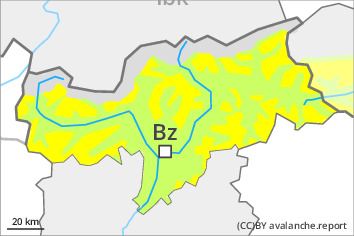
Danger level
 | 2200m |
|  |
|  | ||||
|  |
|  |

Wind slabs and weakly bonded old snow represent the main danger.
Avalanches can be released in the weakly bonded old snow, even by small loads in isolated cases, in particular on steep west, north and east facing slopes above approximately 2200 m, as well as on very steep sunny slopes at elevated altitudes. Avalanches can in isolated cases penetrate deep layers and reach large size. Caution is to be exercised in particular adjacent to ridgelines, as well as in gullies and bowls, and behind abrupt changes in the terrain. The avalanche prone locations are difficult to recognise. The fresh and older wind slabs can be released by a single winter sport participant in some cases in particular on northwest to north to east facing aspects at elevated altitudes. Caution and restraint are required.
As a consequence of warming during the day and solar radiation only isolated gliding avalanches and moist snow slides are possible below approximately 2800 m.
Snowpack
dp.1: deep persistent weak layer
In some cases new snow and wind slabs are lying on a weakly bonded old snowpack. The fresh wind slabs are lying on soft layers in particular on steep shady slopes above approximately 2600 m.
The rain gave rise to thorough wetting of the snowpack over a wide area below approximately 2400 m. A generally clear night: Towards its surface, the snowpack is hard and its surface has a melt-freeze crust that is not capable of bearing a load, in particular on steep sunny slopes, as well as in all aspects at low and intermediate altitudes.
Some snow will fall in the evening in some localities.
Tendency
Weakly bonded old snow represents the main danger.


